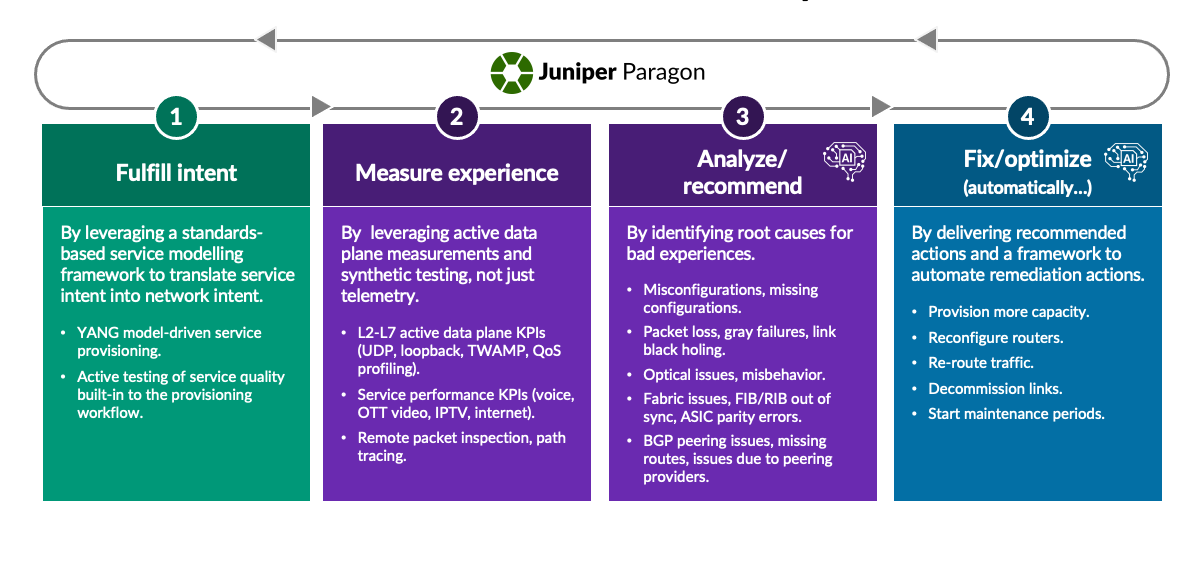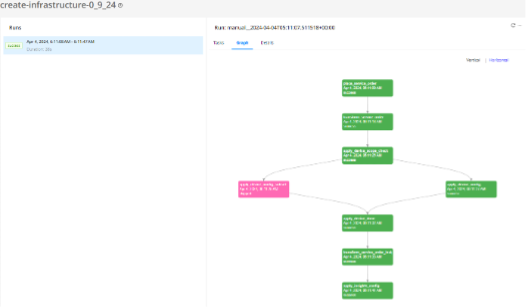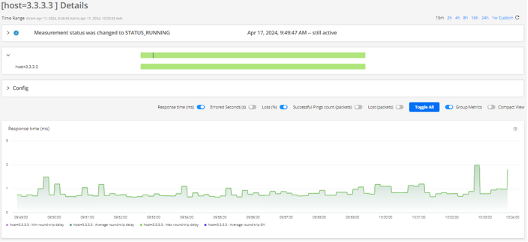It’s a fresh approach to delivering intent through experience-first networking, with everything you need in one place. Slash time and effort, eliminate errors, boost resilience and delight customers.
Flawless performance: no longer the preserve of those with deep expertise and deeper pockets
If you manage your own transport network, this one’s for you. Today, Juniper is launching the all-new Juniper Paragon Automation: one product with multiple use cases, all designed to cut time, effort, and cost in managing a high-performance WAN, by leveraging AI-enabled automation.
In this blog we delve into a brand-new use case: Intent-Based Service Orchestration. Discover how, with Intent-Based Service Orchestration with Juniper Paragon Automation, we are confident you’ll succeed where others have not.
Deploying and managing services across your network infrastructure is hard. Traffic volume is exploding and use cases are diversifying. Programmability, while bursting with potential, means massive complexity. And legacy methods and tools, typically stitched together and often heavily customized, leave operations teams woefully unprepared. That’s why, according to the Uptime Institute, a full 45% of major outages caused by network issues are due to “configuration or change management failure.”[1] It’s like getting into an F1™ car with a manual gearbox and power steering turned off, and trying to make it around the circuit without crashing.
This is an example of how Juniper’s Experience-First Networking approach, applied to the age-old challenge of intent-based networking changes the game almost overnight. It’s not just the features themselves, but the combination of those features upon a common platform that really makes our solution stand out.
Imagine deploying network services to your exact specifications flawlessly; making changes as quick as an F1 pit-stop; and driving service delivery in a way that’s responsive to your changing conditions in real-time; mitigating problems before users even notice. Imagine:
- Cutting service instantiation times from weeks or months to hours
- Eliminating many of 45% of major network outages caused by human error
- Eliminating the 60% of problems that go undetected until reported by the customer[2]
The potential for intent to drive innovation.
The massive configurability of networks today means there are countless ways to design the exact same service. This is a problem, because it means recreating, modifying, or troubleshooting a service first requires knowing how it’s designed. That’s often knowledge trapped inside the heads of a select few experts. Model-based services liberate and codify that expertise in a standard model, so your experts can focus on creating value and raising the bar for user experience.
Three key capabilities, one unique solution. Boost agility, performance, and efficiency.
 Benefits such as these are achieved through a unique combination of three key building blocks that only Juniper Paragon provides from a single AI-Native Networking Platform. Those building blocks are: flexible model-based intent design; automated provisioning, verification, and active assurance; and integrated closed-loop automation.
Benefits such as these are achieved through a unique combination of three key building blocks that only Juniper Paragon provides from a single AI-Native Networking Platform. Those building blocks are: flexible model-based intent design; automated provisioning, verification, and active assurance; and integrated closed-loop automation.
Agility Driven by Intent (Day Zero): Flexible model-based intent design for agility and future-proofness. Eliminate months-long customization projects.
Our solution comes with pre-validated, standards-aligned service models[3], such as L3VPN and L2VPN, which take care of determining and allocating the network resources and configurations needed to fulfil a given business intent. That’s why service design—what might have taken months in the past—can now be done in a matter of hours, with full repeatability and little to zero human involvement.
Just provide the business intent (such as the desired locations, speeds, throughput, latency, and reliability), and Juniper Paragon does everything else. It identifies available resources and defines the required configurations, verification tests, and performance monitoring routines.
Localize services to meet your unique business objectives by configuring and customizing these models yourself, or even build your own service models without the cost and time involved in customizing the underlying orchestration engine, which is logically separated from the model-based designs themselves.
Once your service is live, it’s part of your inventory, which means instead of repeating yourself every time you want to make a change, you can simply pull up the instance, adjust only the parameters you want, and it’s done. You have a full audit trail of changes and who made them: no more searching for service change records in someone’s laptop.
Performance Driven by Intent (Day One): Automated provisioning, verification, and active assurance. No more surprises at 7am on Monday.

At Juniper we believe success in service design requires two things: deep domain expertise, and constant verification at every step in the process. That is why, instead of repurposing third-party products, our experts built an orchestration engine specifically for this task, baking deep domain knowledge alongside active assurance testing and monitoring into the provisioning process itself.
But our solution goes beyond simply verifying configurations; it verifies customer experiences on Day 1 with active testing. Before your service goes live and before you have actual end users, it sends traffic through the network, mimicking the end user. Then it confirms that the stated business intent will be met. So, instead of finding problems, your end users find flawless performance, every time.
Efficiency Driven by Intent (Day Two): Integrated closed-loop automation mitigates problems before the end user even notices. No more panicking in network operations centers.

Preventing severe outages and performance degradations starts with detection and mitigation. Still today, 60% of network problems are first discovered by the end-user. To solve this, our solution automatically builds and deploys active assurance monitors that mirror the stated business intent, so you can see at-a-glance, the health of the services running across your network through the lens of the end user. This eliminates the blind spots that come from relying on device telemetry alone and enables you to detect user-impacting problems even when there are no active users.
And combined with Autonomous Networking use cases such as congestion avoidance and latency-based routing, you can also mitigate problems, gracefully draining traffic from offending nodes and re-routing services to maintain intent (and therefore user experience too). Plus, you can safely investigate the root-cause and restore performance, knowing that no live services will be impacted in the meantime.
See for Yourself
Find out how Juniper Paragon and can reduce service design and deployment time from weeks to days, while eliminating up to 45% of network outages[4] – avoiding not just the estimated average $600k in annual losses[5] but untold reputational damage, all while reducing incremental NetOps OPEX in the process through AI-enabled automation:
- Download the solution brief.
- Get into the details with this white paper from Appledore.
- Watch the webinar.
Learn how GARR, the broadband network dedicated to the Italian research and education community, transformed its network operations with Juniper’s Paragon Automation.
Watch Juniper Paragon: Intent-based networking in action.
[1] Source: Uptime Institute 2023 annual outage analysis survey (n=406)
[2] As reported by a Juniper Survey of CSPs dated 2021
[3] Currently IETF RFCs that define industry consensus of service models for L3VPN and L2VPN
[4] Source: Uptime Institute outage analysis report 2023: 45% of survey respondents cite configuration/change management failure as the most common cause of major network outages (n=406)
[5] Source: Juniper survey: “The hidden cost of network brownouts” (n=400)

























